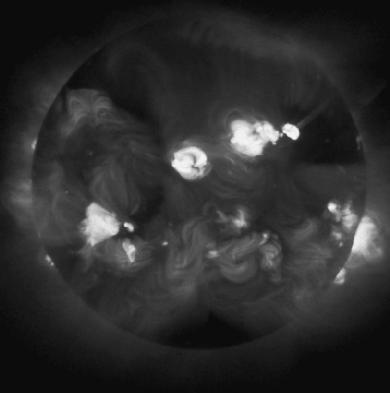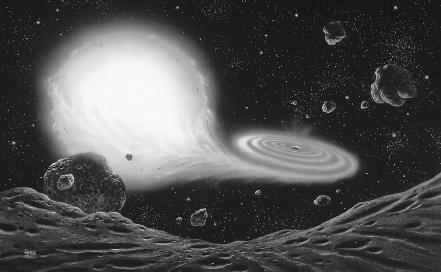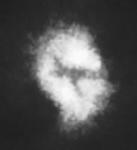Chapter 4
Detecting Black Holes Through Indirect Means
Long before scientists began dreaming about possibly capturing, controlling, and exploiting black holes for humanity's benefit, they dreamed of detecting and directly observing these cosmic oddities in the first place. Einstein, Schwarzschild, Kerr, and many others became certain that black holes could exist, but for a long time they could find no convincing evidence that they do exist.
The obvious problem in detecting black holes was that light's inability to escape them makes them appear black and invisible to human eyes and telescopes. And therefore, scientists could not confirm the existence of these objects by direct visual means. This forced them to resort to in direct means, mainly observations of the behavior of stars, gases, and other matter located near black holes. As it happened, however, the initial detection of black holes was not the result of a concerted effort to find these objects. It came instead as part of a process of elimination as astronomers attempted to explain the workings of some strange, and it turns out crucial, cosmic phenomena discovered in the second half of the twentieth century.
The X-Ray Universe
One of these important discoveries that eventually led to the detection of black holes was that the universe is virtually alive with X rays. These are an invisible form of electromagnetic radiation that is much more energetic and penetrating than visible light. First discovered in laboratory experiments in 1895 by German physicist Wilhelm Roentgen, X rays are familiar to most people from their use in medicine. When a technician aims a beam of X rays at the human body, most of the rays pass through the body and strike a photographic plate, which renders a ghostly image of the patient's insides.

In the years that followed Roentgen's discovery, as artificially produced X rays became increasingly common medical tools, a few astronomers began to suspect that the Sun might produce this energetic radiation naturally. But they had no inkling of the virtual sea of X rays originating from beyond our star. As Herbert Friedman puts it, "There was no hint of the enormous portent [clue or foreshadowing] for the future of astronomy. Astronomers remained oblivious to the potential of X-ray astronomy." 30
The first confirmation that the Sun does indeed produce X rays came in 1948, when American scientists attached detection instruments to rockets developed by the Germans in World War II. Although the instruments did detect solar X rays, they showed that the Sun is not a strong X-ray source; the volume of X rays it produces is only about one-millionth that of the visible light it emits. Thus, it appeared to scientists that stars in general would not prove to be important sources of X rays.
Then, in June 1962, American scientists launched a rocket carrying instruments designed to detect possible radiation coming from the surface of the Moon. The experiment found no radiation on the

Moon. But it did quite unexpectedly detect a powerful X-ray source located beyond the solar system. Later rocket launches confirmed the existence of this source and pinpointed it in the constellation of Scorpius, the scorpion. Astronomers named it Scorpius X-1, or Sco X-1 for short.
After that, other distant, very powerful X-ray sources were discovered, especially following the December 1970 launch of a more sophisticated X-ray satellite. This device, named Uhuru, and several even more sensitive probes launched later, revealed that the sky is literally filled with X-ray sources; some scientists began to refer to this previously unknown phenomenon as the "X-ray universe."
A Black Hole's Presence Revealed
It soon became clear to astronomers that Sco X-1 and many similar strong X-ray sources, including the pulsar in the Crab Nebula, are neutron stars. And they were able to develop a model to explain how neutron stars that are part of binary star systems can emit strong bursts of X rays. John Gribbin explains that in a binary star system, the two objects, one a normal star and the other a small superdense neutron star, are
orbiting each other, locked in a mutual gravitational embrace…. Gas from the atmosphere of the large star will be torn away from it by tidal effects and attracted to the small star. As the gas spirals down onto the small star, it will form a swirling disk of material, generating heat within the disk itself…. The small, dense star is surrounded by very hot gas, or plasma, which radiates at X-ray wavelengths … and is constantly being renewed by gas falling in from the larger star. 31
The fact that these strong X-ray sources are neutron stars indicated to astronomers that large bursts of X rays are often associated with superdense cosmic bodies. Considering this, at least a few scientists could not help but suspect that another kind of superdense object—the then hypothetical black hole—might somehow reveal its presence by producing X rays. And indeed, one strong X-ray source first detected in the 1960s did seem to be a promising black hole candidate. Located in the constellation of Cygnus, the swan, it became known as Cygnus X-l, or Cyg X-1 for short.
Like Sco X-l, Cyg X-1 is part of a binary star system. But unlike the case of Sco X-l, the object orbiting the normal star in the Cyg X-1 system emits no visible light at all. Also, the bursts of X rays coming from Cyg X-1 occur at astonishing rates—as high as a thousand or more per second. This tells astronomers that the invisible object must be extremely small and compact. According to Friedman (who in the 1960s boldly predicted that Sco X-1 was a neutron star):
A star cannot change its brightness in less time than it takes light [or X rays and other forms of electromagnetic radiation] to cross its diameter…. Thus, when Cyg X-1 exhibited millisecond bursts, it meant that the X-ray-emitting region could be no more than 300 kilometers [about 186 miles] across. 32
Another reason why scientists suspected that the Cyg X-1 object is a black hole is that it is tremendously massive for such a tiny body. The normal star in the system is a giant of about thirty solar masses. Astronomers were able to work out its orbital characteristics and from this calculate the mass of the invisible companion. They found it to be nine solar masses, too massive to be a neutron star, which strongly suggested that the Cyg X-1 system harbors a stellar black hole.
It is now clear that Cyg X-1 emits such strong bursts of X rays through a combination of the black

hole's powerful gravity and its close proximity to the larger companion star. The black hole is a bit closer to the other star than the planet Mercury is to the Sun. (Mercury lies about 36 million miles from the Sun.) Such extremely close quarters for these massive bodies allow the black hole's gravity to draw gases from the outer layers of the companion. As these gases spiral in toward the denser object, they form a huge, rapidly spinning, and very hot accretion disk around the outside of the hole's event horizon. Slowly but surely, some of the gases are pulled right up to the horizon, where the hole's immense gravity tears the gases' atoms apart. This extremely violent process releases strong bursts of X rays only an instant before the stream of matter disappears forever beyond the event horizon. In the minutes, days, and years that follow, the X rays emitted in this manner travel outward, eventually reaching Earth and showing scientists the position of the black hole.
The Mystery of Gamma-Ray Bursts
Black holes likely also reveal their presence by generating powerful bursts of gamma rays. Even more energetic than X rays, gamma rays are in fact the most energetic and penetrating kind of radiation in the electromagnetic spectrum. Like X rays, in high enough doses gamma rays can be lethal to living things; that is why doctors sometimes use small, controlled doses of gamma rays to destroy cancerous tumors.
Also like X rays, gamma rays captured the attention of astronomers in the 1960s. Detectors mounted on American rockets began to record strange, very powerful bursts of gamma rays coming from random parts of the sky. Typical bursts lasted a few seconds, although some flared up and then diminished in less than a second. Because nuclear explosions emit brief bursts of gamma rays, at first American scientists and security personnel worried that the Soviet Union might be conducting secret nuclear tests beyond Earth's atmosphere.
By 1973, however, scientists had become convinced that the gamma-ray bursts (or GRBs) are a naturally occurring phenomenon originating deep in space. A new burst was detected at least once a week on average. Although the GRBs varied in intensity, some were truly enormous, in the range of a billion trillion times the luminosity of the Sun. Put another way, a big GRB releases as much energy in 10 seconds as the Sun does in 10 billion years. Astronomers were very hard pressed to explain what could be causing these huge cosmic outbursts. From 1973 to 1991, the prevailing theory was that GRBs were telltale signs of "star quakes" (similar to earthquakes) on neutron stars; some thought that perhaps a wayward planet crashing into a neutron star releases a sudden burst of gamma rays.
In recent years, however, astronomers have concluded that the physical attributes of gamma-ray bursts are better explained as by-products of the workings of large black holes. Several different scenarios have been suggested; any one of them, and indeed perhaps all of them, may be occurring at intervals not only in our own galaxy, the Milky Way, but also in the billions of other galaxies lying beyond it.
One recent hypothesis, advanced by MIT scientist Maurice Van Putten, suggests that in binary star systems containing a normal star and a black hole, the black hole eventually siphons off nearly all of the companion star's material. Finally, all that is left of the normal star is a doughnut-shaped ring that becomes part of the hole's spinning accretion disk. In the span of only a few seconds, the hole sucks in the remaining pieces of the companion, in the process creating an enormous outburst of gamma rays.
When Black Holes Merge
Strong evidence that black holes do sometimes collide and merge was recently discovered by David Merritt, of Rutgers University, and Ronald Ekers, of the Australia Telescope National Facility. They studied patterns of radio waves given off by a group of distant galaxies. One strange feature that these galaxies have in common is a curious X-shaped structure at their centers. Merritt and Ekers believe that the four lobes making up such an X are high-speed jets of material emitted from a black hole that has recently merged with another black hole. In this view, the violence of the merger knocks the new black hole off its axis, and for a while it emits two sets of jets, one from its previous alignment, the other from its new alignment.
In an interview by Vanessa Thomas in the November 2002 issue of Astronomy , Merritt says, "Black holes are so large and massive, the only thing we can imagine that would have enough force to realign them is another black hole…. [Before this discovery] most astronomers were fairly sure that black holes coalesce, but we now regard the X-shaped galaxies as the first 'smoking-gun' evidence."

In another scenario, a large GRB is generated when a stellar black hole collides with either a neutron star or another black hole. In either case, the colliding bodies would merge as one, releasing an immense burst of energy. "The two stars spiral together," Begelman and Rees speculate,
slowly at first and then faster and faster, until they finally merge. The final coalescence, perhaps lasting only a millisecond, would certainly trigger a large enough release of energy. Such events are rare—they would occur only once every 100,000 years in a typical galaxy. But there are at least a billion galaxies within [effective range of human detectors], so the rate at which bursts are detected [about one per day by the late 1990s] poses no real problem. 33
In still another model for black holes and GRBs, a large gamma-ray burst occurs when people on Earth witness the birth of a stellar black hole from a specific and favorable angle. In this view, the tremendous collapse of a giant star into a black hole produces more than a supernova and a superdense object. The implosion also generates an enormous outpouring of gamma rays from the collapsing object's poles. Because the alignment of such objects in the universe is random, only rarely will one's poles point directly at Earth. When they do not line up, humans see only the bright flash of the supernova; but when the object's poles are aligned with Earth, human instruments record a giant outburst of gamma rays as well as the supernova.
Solving the Riddle of Quasars
Gamma-ray bursts are not the only cosmic mystery that astronomers have attempted to solve by invoking the bizarre properties and effects of black holes. In 1963, an extremely strange object was discovered in the constellation of Virgo, the virgin. Dubbed 3C 273, the object is situated at the enormous distance of 2 billion light-years from our solar system. (This means that it takes light and other radiation emitted by the object 2 billion years to reach us!) Astronomers noted that 3C 273 gives off both visible light and strong jets of radio waves and other kinds of electromagnetic radiation. What made the object seem so unusual was that this outpouring energy is hundreds of times greater than that of the entire Milky Way galaxy, which is made up of billions of stars; yet 3C 273 appeared to be extremely small—the size of a single star. Thus, the bizarre object and others like it discovered in the years that followed looked something like stars. But they were obviously not ordinary stars. So astronomers called them quasi-stellar ("starlike") objects, or quasars for short. By 2003 some thirteen thousand quasars had been found; and experts estimate that as many as ninety thousand more will be discovered in the next couple of decades.
At first, astronomers had no credible idea of what could be causing quasars to shine so brightly. Nor did they think to connect them with black holes, which in the early 1960s were still viewed as fascinating but mainly hypothetical constructs. As time went on, however, careful observations of quasars revealed certain exotic characteristics increasingly associated with superdense bodies. In the words of University of Alabama astronomer William C. Keel:
Despite shining far brighter than ordinary galaxies, quasars change brightness on short time-scales. Indeed, their X-ray output can vary in minutes . … This shows that most of the radiation must come from tiny regions, maybe no more than light-hours across, or roughly the orbit diameter of Uranus or Neptune. Along with their small size, quasars must have central engines with gravitational fields strong enough to hold onto gas that's moving at thousands of kilometers per second. Also, the gas must be exposed to high temperatures or energetic radiation to create the observed … [amount of] X-ray emission. Finally, the extent and speed of the radio-emitting jets show that the source has a directional memory [i.e., always emits the jets in the same direction] and can eject material so close to the speed of light that it escapes in spectacular fashion. So what kind of an object can do all this? The most reasonable explanation is an enormous black hole. 34
Twinkle, Twinkle Quasi-Star
For a number of years scientists viewed quasars as weird and mysterious objects that did not seem to belong in the "normal" universe. This air of mystery was captured perfectly in 1964 by renowned Russian-born American physicist George Gamow (1904–1968) in a short poem titled "Quasar" (which has since that time been reproduced in hundreds of books and articles about black holes, quasars, and other cosmic oddities).
Twinkle, twinkle, quasi-star
Biggest puzzle from afar
How unlike the other ones
Brighter than a billion suns
Twinkle, twinkle, quasi-star
How I wonder what you are.

A quasar-producing black hole gives off a tremendous outburst of energy in much the same way that an ordinary stellar black hole reveals itself by an X-ray signature. In the latter situation, matter from the accretion disk that is about to cross the event horizon is annihilated, releasing powerful bursts of X rays. Astronomer Mark A. Garlick describes the similar process involved in quasar formation:
Most astronomers are now convinced that a vast accretion disk of gas and dust, the gravitationally shredded remains of countless stars and nebulae [cosmic gas clouds], surrounds the black hole in a quasar. As the gas in the disk spirals toward the black hole's deadly maw, the material becomes so compressed and heated that it generates the truly enormous quantities of light that make quasars conspicuous across billions of light-years. 35
What, then, makes a quasar-producing black hole different from an ordinary stellar black hole? Keel and Garlick hint at the answer in their use of the phrases "enormous black hole" and "vast accretion disk." Only a black hole that has acquired a gigantic mass—equal to that of millions or even billions of stars—could produce the spectacular celestial fireworks called quasars. The notion that such objects could actually exist was eye-opening enough for scientists. But even more intriguing was the fact that quasars are always located in the centers of galaxies. From this realization, it was only a minor leap to the startling suggestion that gigantic black holes might exist in the hearts of all galaxies.